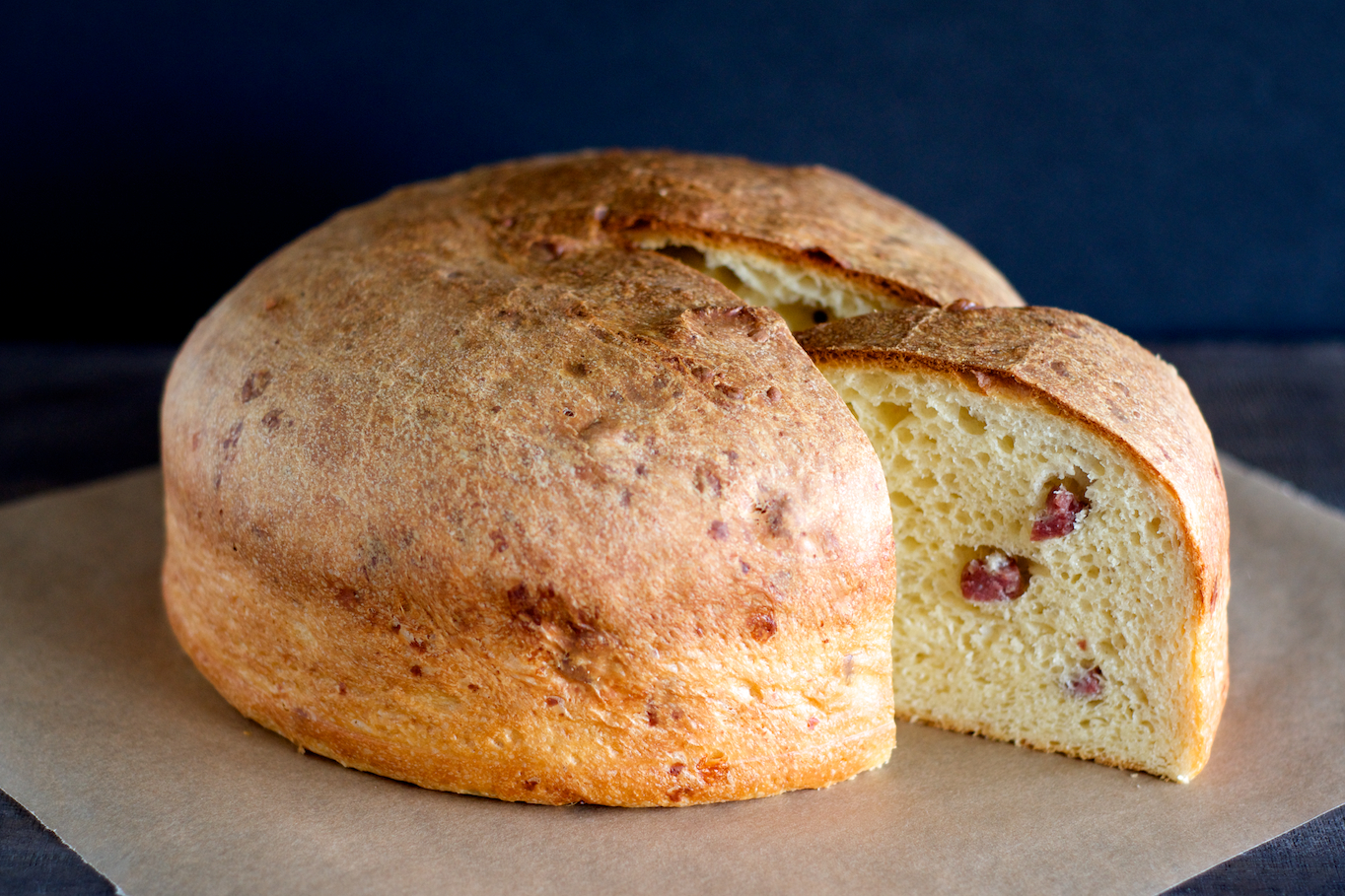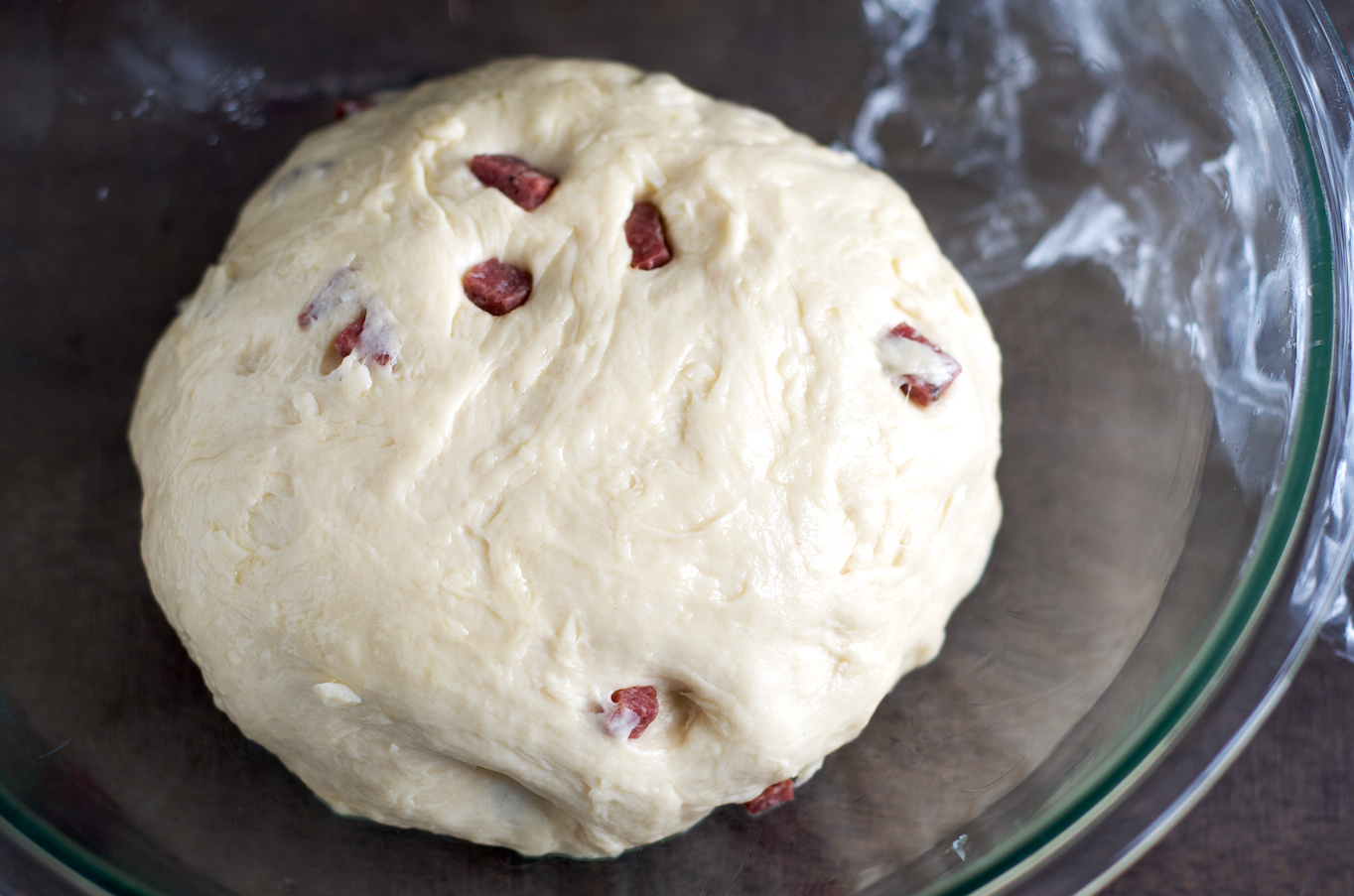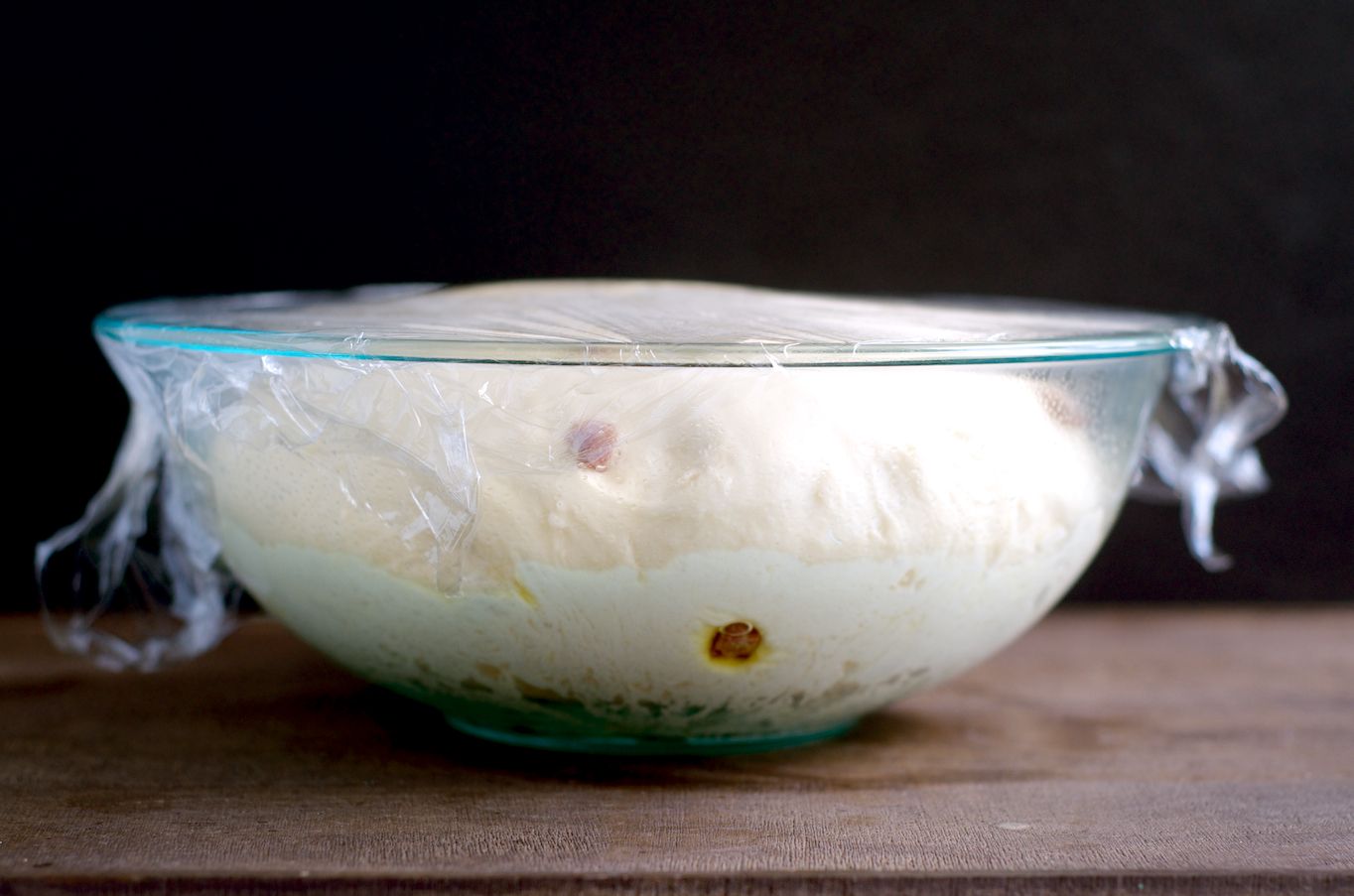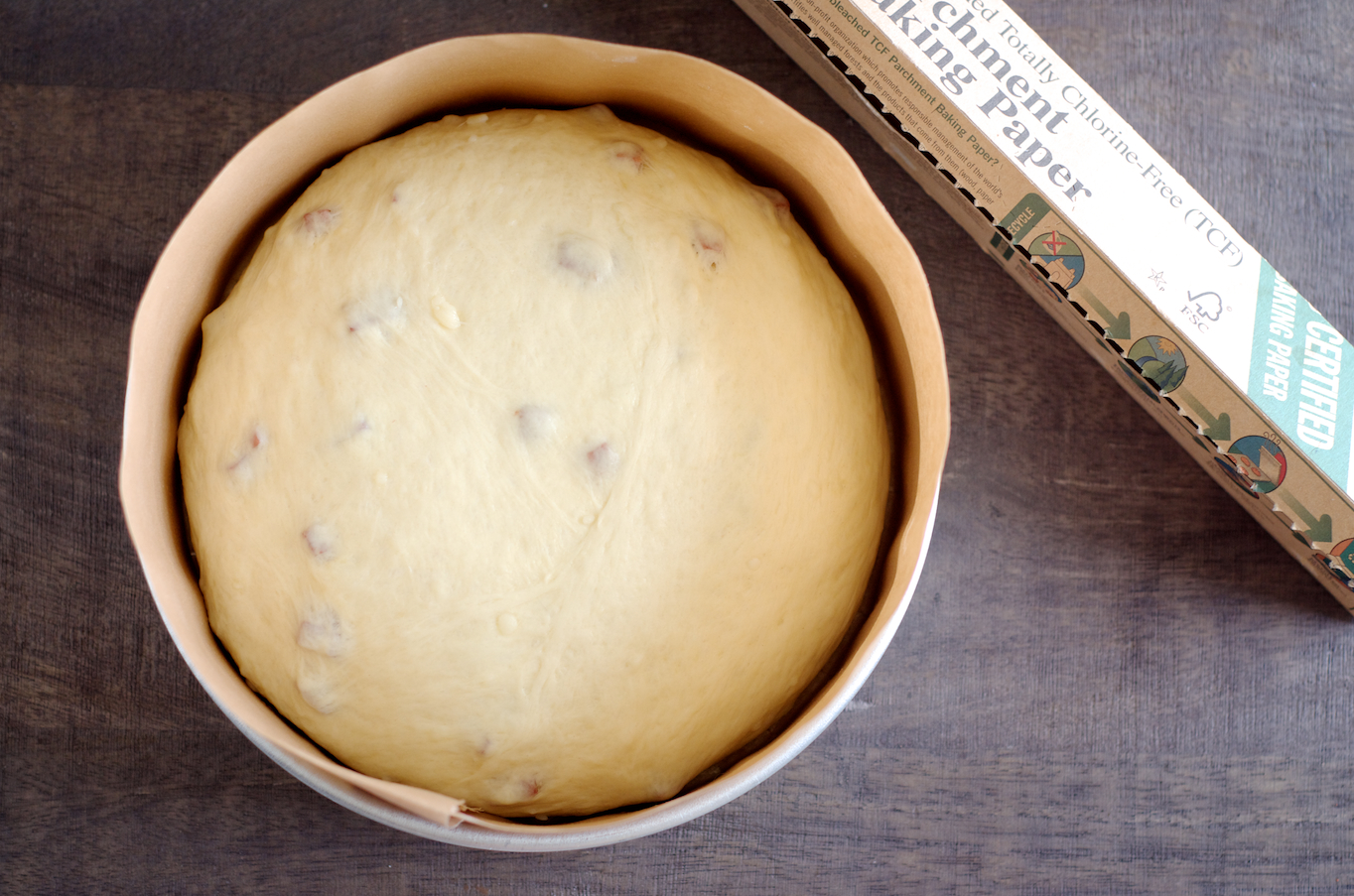
This bread is so incredibly good. It is delicious warm out of the oven with melty little pockets of cheese and meat, but also makes some insanely awesome toast. And as an added bonus it can be made, start to finish, in about 5 hours; no overnight waiting or extended fermenting required.

The bread should be soft, airy and rich. Traditionally it is a Neapolitan bread served for Easter, but it is delicious any time of the year. Growing up, we never made Casatiello in my family, we made a different Easter bread with anise seeds.



The sponge should be whisked into a smooth, pancake-like batter and then covered with plastic wrap to ferment. It will bubble and puff up, and then collapse or deflate when tapped or moved.



I really like the look of the large round loaf, but you could also bake this into smaller loaves. I added a parchment collar around the rim of the pan to make sure the sides of the bread stayed straight and promote easier removal after baking.


I like using a thermometer to test for doneness because it takes all of the guess work out, however if you don’t have a thermometer you can tap on the bottom of the loaf and listen for a hollow sound. The sides should also be firm, not soft and crushable.

Casatiello
Adapted, slightly from The Bread Baker’s Apprentice Makes one large loaf (pictured above) or two small loaves This super moist, tender bread is deliciously buttery, flecked with salty meat and melty cheese. It is like a “savory version of pannettone”. The bread is good warm out of the oven, but also makes killer toast. Feel free to experiment with different meats and cheeses. I used salami, but pepperoni, cooked and crumbled bacon, pancetta, or sausage would also be incredible. For the cheese you want to select something flavorful that melts well so it creates little pockets of cheese. I used a combination of provolone and fontina since that is what I had on hand, but Swiss, Gouda, or Cheddar would also be awesome. Also, the book also provides the option for using buttermilk instead of regular milk to give the bread a tangy flavor.Sponge
1/2 cup (2.25 ounces) unbleached bread flour 1 tablespoon (0.33 ounce) instant yeast 1 cup (8 ounces) whole milk or buttermilk, lukewarm 90° to 100°FDough
4 ounces dry-cured Italian salami or other meat (see note above) 3 1/2 cups (16 ounces) unbleached bread flour 1 teaspoon (0.25 ounce) salt 1 tablespoon (0.5 ounce) granulated sugar 2 large (3.3 ounces) eggs, slightly beaten 3/4 cup (6 ounces) unsalted butter, at room temperature 3/4 cup (6 ounces) coarsely shredded or grated provolone or other cheese (see note)
To make the sponge, stir together the flour and yeast in a bowl. Thoroughly whisk in milk to make a pancake-like batter. Cover with plastic wrap and ferment at room temperature for one hour. The sponge will foam and bubble, and should collapse/deflate when you tap the bowl.
While the sponge is fermenting, dice the salami into small cubes and sauté it lightly in a frying-pan to crisp slightly and render some of the fat out. If you are using a meat other than salami, prepare it now. You can also reserve the rendered fat and substitute, one for one, in place of the butter.
To make the dough, in a mixing bowl (or in the bowl of an electric mixer), stir together the flour, salt, and sugar with a spoon. Add the eggs and sponge and mix together (or mix with a paddle attachment on low-speed) until all the ingredients form of coarse ball. If there is any loose flour, dribble in a small amount of water or milk to fully incorporate the dry ingredients into the dough. Stir (or mix) for about a minute, then let the dough rest for 10 minutes to allow the gluten to develop. Divide butter into four pieces. Begin working butter into dough, one piece at a time, stirring vigorously with a spoon (or mixing on medium speed) until all butter has been incorporated. The dough will be soft, but not batter. If mixing by hand, continue mixing with a spoon, or switch to your hands but keep them well floured. Knead on clean counter once butter is incorporated, working the dough into a smooth tacky mass, about 12 minutes; add flour only as needed. If using a stand mixer, switch to dough hook once butter is fully incorporated. Knead on medium until the dough changes from sticky to tacky and no longer sticks to sides of bowl, about 8-10 minutes; scraping down bowl when needed. If the dough does not clear sides of bowl, sprinkle in small amounts of flour until dough forms a ball and clears the sides of the bowl.
When the dough is smooth, add the meat pieces and knead (or mix) until they are evenly distributed. Then gently knead (or mix) in the cheese until it has been evenly distributed. The dough will be soft and stretchy, very tacky, but not sticky. If it is sticky sprinkle in a little flour until it firms up. Lightly oil a large bowl and transfer dough to bowl, turning once to coat with oil. Cover bowl with plastic wrap.
Ferment at room temperature for about 90 minutes or until the dough increases in size by at least 1 1/2 times. Remove dough from bowl and leave as one piece for one large loaf or divide into two pieces for two smaller loaves. Lightly dust your hands and dough with flour.
For large round loaf, spray an 8 or 9-inch cake pan with spray oil. I created a parchment collar to make sure the bread didn’t mushroom over the top of the pan, and make it easier to get out of the pan. Shape dough into a boule (tight round loaf). Place in pan and every so gently press down to better fill the base of the pan. Mist the dough lightly with spray oil, and cover lightly with plastic wrap.
For two smaller loaves, spray two 8 1/2 by 4 1/2-inch pans with spray oil. Shape the dough into two sandwich loaves, and place in pans. Mist the dough lightly with spray oil, and cover lightly with plastic wrap.
The loaves can also be baked in white or brown sandwich-sized (lunch) paper bags set in metal cans just large enough to hold them or paper panettone mold(s). If using bags, spray generously with spray oil.
Proof for 60 to 90 minutes. Depending on the height of your pan, the dough should just crest the top of the pan.
During the last 20 minutes of the rise, start oven pre-heating to 350-degrees F, with the oven rack placed in the lower third of the oven.
Place pan or pans in the oven. For large round loaf bake for 25 minutes, then rotate pan 180-degrees and bake for another 25-35 minutes. For smaller loaves, bake for 20 minutes, rotate 180-degrees and bake for another 20-30 minutes. The loaves should be golden brown on the top and sides, and register an internal temperature of 185 to 190-degrees F. If you don’t have a thermometer, tap on the bottom of the loaf and listen for a hollow sound. The sides should also be firm, not soft and crushable.
Remove baked bread from pans and transfer to cooing rack; if baking in bags, cut slits in bags or remove completely to allow steam to escape. Let bread cool for at least one hour before slicing.

Anne says
Beautiful bread! I love the magic between dough and bread. Simply amazing!
Meagan says
Beautiful bread! Do you think you can make this using the dough setting on a bread machine?